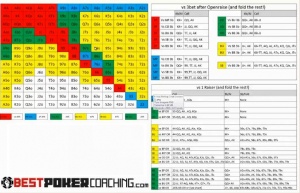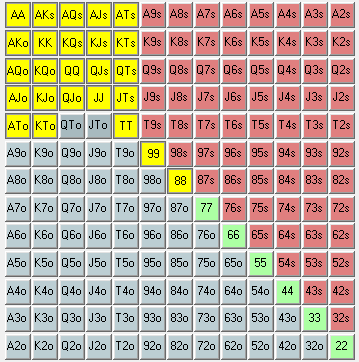Poker 3 Bet Strategy
By Alton Hardin
- Poker 3 Bet Strategy Odds
- Poker 3 Bet Strategy Poker
- Poker 3 Bet Strategy Games
- Poker 3 Bet Strategy Challenge
- Poker 3 Bet Strategy Tactics
- Poker 3 Bet Strategy Video Poker
- Poker 3 Bet Strategy Rules
Introduction

For beginners, 3-betting can be a confusing concept to understand and properly apply at the poker tables. With so much theory being discussed in books, forums, and training videos its easy for beginners to get lost in a fog of poker haze, not knowing when to 3-bet, what range of hands to 3-bet and why. The purpose of this article is to provide a basic framework that beginning and struggling poker players can use to effectively 3-bet.
Optimal strategy for 3 Card Poker indicates that you should generally play all hands of a value of Q-6-4 or better and fold everything else. This casino table game will always give the house a slight edge of around 2% over the long-term. One of the first steps to incorporating 3-bets into your overall poker strategy is to understand exactly who you should be 3-betting. Of course, the strength of your hand will play a part in this decision, but it is not the only factor that you should consider.
What Is The Pre-Flop 3-Bet?
First off, lets level set what a pre-flop 3-bet is. A 3-bet occurs when someone open-raises and another person re-raises pre-flop. The re-raise is a 3-bet. This might be a bit confusing to some people because the 3-bet is the second raise, why is this? Well, in Texas Holdem the posted blinds are considered the first bet, the initial open raise is considered the second bet, and the re-raise is therefore the third bet, hence the term 3-bet.
Linear and Polarized 3-Bets
In poker, there are two main categories of 3-bets, linear and polarized 3-bets:
Linear 3-Betting Range
A linear 3-betting range is one composed solely of value-bets. When we 3-bet a linear range, we are 3-betting for value. For example, the image below shows a linear value 3-betting range of JJ+, AQs+, AKo.
Poker 3 Bet Strategy Odds
Polarized 3-Betting Range
A polarized 3-betting range is one composed of a combination of value hands and bluffs. So, unlike the linear 3-betting range, when we 3-bet a polarized range, we are sometimes betting for value and other times bluffing. The below image shows a polarized 3-betting range composed of value hands and bluff hands. In this example, we are 3-betting TT+, AJs+, AQ+ for value and 44-22, A4s-A2s, 87s, 76s as a bluff.
Why Do We 3-Bet?
Hopefully you’ve already noticed this from the section above, but we 3-bet for two specific reasons:
- When we have a hand that is too good to call, such as KK or AA for value
- When we have a hand that is too bad to call, such as A2s or 33
If we have a hand that fits within these two different reasons, then we have a hand we can “potentially” 3-bet.
Linear or Polarized?
So which should you use, the linear or polarized 3-betting model? It depends on our opponents.
Can We 3-Bet Bluff?
You probably heard the phrase, “never bluff the calling station”. Well the same goes for 3-bets. You should only apply the polarized 3-betting model with 3-bet bluffs if your opponent(s) are folding to a lot of 3-bets. If they aren’t, then 3-bet bluffing will only cause you to unnecessarily spew off a lot of chips pre-flop. Conversely, if your opponent(s) are folding to a high frequency of 3-bets, approximately 67% then you can 3-bet bluff profitably.
Therefore, 3-bet bluffing and the polarized 3-betting model works best when you have a lot of fold equity. When your fold equity is low, don’t apply this model and stick with the linear 3-betting model.
How Wide Should We Value 3-Bet Bet?
Again, this is dependent upon how your opponent(s) are reacting to 3-bets. When you are 3-betting for value, the most important factor is your opponent’s 3-bet calling range and 4-betting range.
When you are 3-betting for value, you goal is to maximize your long-term expectation in the hand by having your opponents call your 3-bet with worse hands. For example, if your opponent is folding to 100% of 3-bets (this isn’t really realistic but proves a point), then it does you no good to 3-bet KK or AA. Against this specific opponent it is more profitable to flat his or her pre-flop raise. Conversely, if your opponent is folding to next to no 3-bets, then it is highly profitable to 3-bet a very wide range for value!
So here are some general guidelines on 3-betting for value:
- Always adjust your 3-bet value range to how your opponents react to 3-bets
- Consider your opponent’s 3-bet flatting range and 4-betting range
- The less your opponent is folding to 3-bets, the more you can widen your value range
Low versus High Fold Equity
Therefore, if you have high fold equity you should employ the polarized model. If you have low fold equity, use the linear 3-betting model.
3-Bet Sizing
When sizing your 3-bets, I recommend beginner start with the 3x rule: raise three times your opponents initial open raise sizing.
- When you are out of position to the raiser, make your sizing a bit more, closer to 3.5x. Why? Our positional disadvantage in the hand.
- When you are in position to the raiser, make you sizing a bit less, closer to 2.8x. Why? Our positional advantage in the hand.
Summing Up
This short poker strategy article on 3-betting 101 covered the basics behind 3-betting and linear versus polarized 3-betting ranges. While this article is far from being a comprehensive 3-betting strategy guide, it should help guide beginners in the right direction with their 3-betting game.
For a more comprehensive overview of 3-betting, be sure to watch our The Three-Betting 101 Course!
Winning at poker isn’t all about fundamentals.
There are a handful of special moves that, when mastered, can make the difference between winning a little and winning a lot.

In this 10-part beginner poker strategy series we’ll show you exactly how to use these powerful poker moves to make more money.
Today we’re talking about the light three-bet. This is another way to pick up pots even when you don’t pick up a big hand.
By incorporating light three-betting into your pre-flop repertoire you’ll not only exploit loose open-raises, you’ll also balance your range to help you get paid off when you do pick up premium cards.
How to Make a Light 3-Bet
The What: Light three-betting refers to putting in a re-raise before the flop with hands that are probably worse than the opening raiser’s hand.
The When: Try to identify and attack loose players who are open-raising too often.
The Where: When you’re three-betting light you’re going to be in one of two spots -- either re-raising in position or from the blinds. It’s important to understand both scenarios.
The Why: Loose players who raise too much before the flop can be exploited because they’ll be forced to fold a lot of their marginal hands to a three-bet.
Light Three-Betting Done Right
To make things easy, just think about a light three-bet as a semi-bluff. You’re raising with a hand that, while not the best hand at the moment, has fold equity and can become the best hand on later streets.

Because one of the first things poker players learn is to be more aggressive, you’ll encounter a ton of players open-raising too much before the flop.
Once you’re able to identify these players you can exploit them by putting in a re-raise, even if you don’t have the cards to back it up.
It’s important to remember, however, that you must harness the power of the light three-bet or it could quickly become a big leak. The biggest risk for beginner players is not understanding how to play the hand post-flop when your opponents do call.
Poker 3 Bet Strategy Poker
Don’t let the hand get away from you by automatically firing a continuation bet and multiple bullets on later streets. One way to deal with this is by only three-betting very good hands and very marginal hands with good flopability.
Related Reading:
Poker 3 Bet Strategy Games
Pro Tip: Polarize your three-betting range to make things easier post-flop
By staying away from hands like weak aces and big paint cards you’ll be faced with easier decisions later in the hand and you’ll cut down on times when you do flop something, but are dominated.
Good Hands to 3-Bet Light
Just because you’re widening your three-betting range doesn’t mean you should be re-raising every hand willy-nilly.
Going back to the analogy of the semi-bluff, you want to choose hands that have a good chance at becoming the best hand on the flop or on later streets.
Small pocket pairs are great hands to three-bet since sets are going to be the best hand the vast majority of the time. The same goes for small and medium suited connectors.
And as we discussed before, when you miss the flop with hands like these you’re less likely to get dragged into a big pot holding the worst hand.
Related Reading:
Light Three-Betting Balances Your Range
Balancing your range is a fancy way of saying that just because you’re raising pre-flop, it doesn’t mean you have a premium hand.
If you’re only three-betting with aces and kings your opponents will catch on and it will be impossible to get paid when you do pick up a monster. By raising with premium hands as well as speculative hands you have a more balanced three-betting range.
Imagine you’ve three-bet light with 8♦9♦ and ended up making a flush on the turn. When you show down that winning hand your opponents will take note that you three-bet with a marginal hand.
Then when you do pick up aces they’ll be much more likely to pay you off.
Related Reading:
Why Light 3-Betting Works
Poker 3 Bet Strategy Challenge
Light three-betting is one of the first intermediate Texas Hold'em moves you should add to your poker skill set because it helps counteract a common problem you'll find in most Hold'em game: aggressive opponents.
It's also especially important in tournaments when the blinds and antes get big and you can't just sit and wait for a premium hand. A lot of players understand that they need to open-raise a lot of pots but when they start doing that too often with weak hands they leave themselves open to getting four-bet.
If you can pick out these profitable spots to 3-bet light you can re-raise and force them to fold regardless of what your cards are. Watch the video below to see how it's done and continue your studies with our more comprehensive article on raising and three-betting before the flop.
Poker 3 Bet Strategy Tactics
Light Three-Betting in Action
Poker 3 Bet Strategy Video Poker
If you’re still not convinced about the power of the light three-bet check out this video featuring Phil Ivey, Lex Veldhuis and Barry Greenstein. This hand takes the concept to the absolute extreme with a light three-bet, cold four-bet and a massive five-bet bluff jam.
Poker 3 Bet Strategy Rules
Learn More Essential Texas Hold'em Moves: